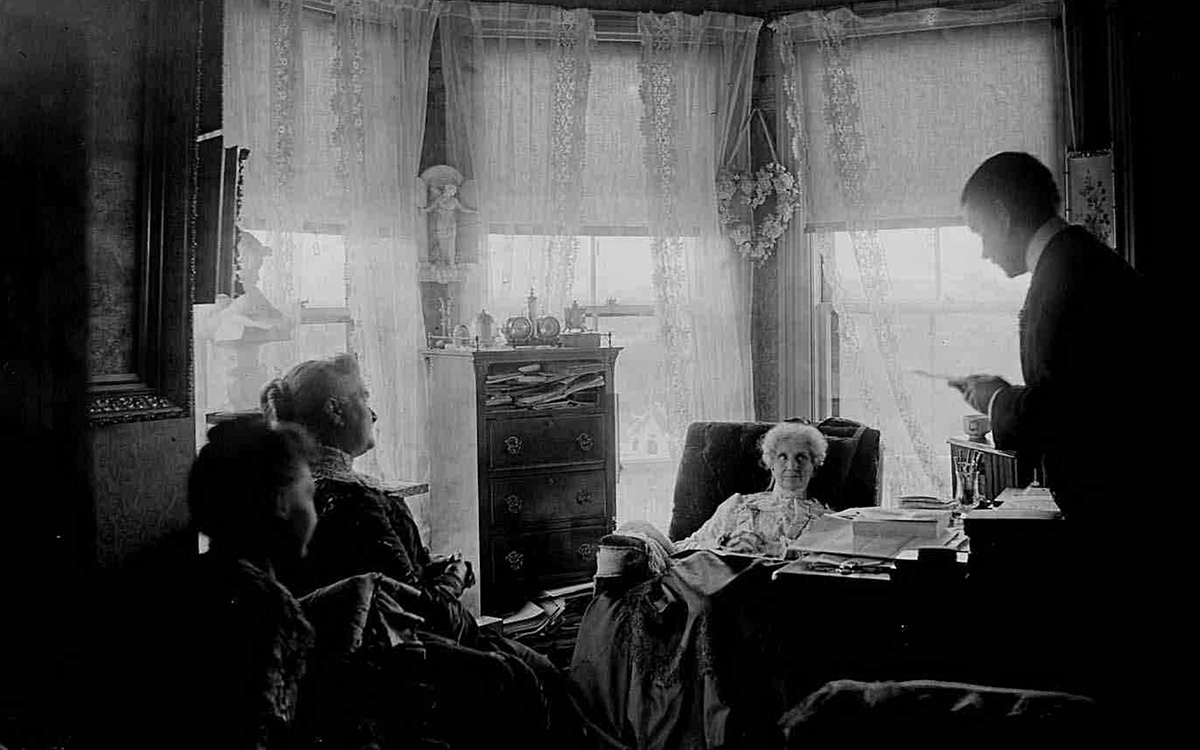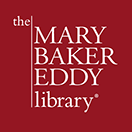What did Eddy say about weather and climate?

Mary Baker Eddy meets with staff members at Pleasant View in Concord, New Hampshire, c. 1903. Eddy is seated at her desk. John Lathrop stands with paper in hand. Seated at left are Lida Fitzpatrick and Pamelia Leonard. P00049. © TFCCS.
Throughout her life, Mary Baker Eddy lived in an area of the United States prone to climatic extremes. Having grown up on a farm, she was certainly aware of the impact that weather conditions could have on people’s economic and physical well-being. And in teaching Christian Science, she identified weather forces as subordinate to God.
Irving Tomlinson was a student of Eddy and worked on her staff for a number of years. He described her approach to the weather this way:
Mrs. Eddy taught us that weather conditions are not beyond God’s control, and that they can be corrected through right prayer. She made it clear that Christian Scientists are not to attempt to control or govern the weather. We should know that God governs the weather and no other influence can be brought to bear on it. She said we are to be particularly watchful to guard against any disastrous effects of storms.1
Eddy’s correspondence and other writings indicate that she specified violent weather elements in particular as requiring ongoing prayerful attention. In November 1900, her Thanksgiving statement, which appeared in The Boston Globe, concluded, “…the atmosphere of the human mind, when cleansed of self and permeated with divine Love, will reflect its subjective state in clearer skies, less thunder bolts, tornadoes and extremes of heat and cold.”2
Eddy often asked people to pray about violent weather conditions. For example, on May 19, 1906, she wrote to the Christian Science Board of Directors, outlining the approach she wanted them to take:
…consider this my proposition – That you require some of the best C. Scientists in Boston and vicinity to pray once each day that no thought of earthquake tornado or destructive lightening enter thought to harm it but that He who reigns in the heavens and watches over the earth saves from all harm.3
A week later she followed up, enlarging that list to include “inundation, flood, destructive lightening, earthquake tornado or cyclone.”4 At another time she advised her longtime associate Laura Sargent, “Watch the clouds and if a bad looking cloud is gathering scatter it and allow the rain but no cyclone or tornado or dangerous lighting does God send hence you can know it does not come.”5
Eventually Eddy requested the establishment of an official “Benevolent Committee” for The Mother Church, its members paid to pray for sufficient rainfall, as well as for the prevention of destructive weather.6
Clara Knox McKee was Eddy’s personal maid in 1906 and 1907. She recounted an experience that helps to illustrate further the distinction Eddy made between attempting to control the weather and holding it as a subjective state of human consciousness:
One day Mrs. Eddy called her students into her study and pointed to a very black cloud, shaped like a cornucopia, coming toward the house in direct line with her front study window. She asked each one to go to a window and face it, and to realize that there were no destructive elements in God’s creation. While the cyclone came whirling straight toward Pleasant View, before it reached within a mile or so, it parted and went around Concord and into the mountains, doing very little damage in our neighborhood.7
On another occasion, Eddy helped a local farmer who faced extreme weather conditions, despite the fact that they did not change. His well had gone dry, and his cows were stopping their production of milk. Clara Shannon, who worked closely with Eddy for over 20 years, remembered the experience:
It was so bitterly cold that everything was frozen and the well from which he obtained water for his cattle was empty. On the day before he was obliged to go to a brook or river, which was frozen, some distance away. He had taken barrels in his wagon which he filled with ice and snow from the river and took home to melt, so as to have water for his cows. This was very hard work, it took a long time and he seemed much distressed. During that day I mentioned his difficulties to [Eddy], telling her just what had happened. She smiled and said “Oh! If he only knew”; then, after a moment’s silence, “Love [God] fills that well”. The next morning, when the farmer brought the milk, he was overjoyed and told Miss [Martha] Morgan that a wonderful thing had occurred. That morning early when he had gone out to attend to the cattle, he found the well full of water, and in spite of the bitter, cold day with all the ice and snow round, the well was full of water. He said it must have been Mrs. Eddy’s prayers that had done it all. She must have had something to do with it for it was a miracle. He had a great reverence for Mrs. Eddy although he was not a [Christian] Scientist.8
Another aspect of Christian Science practice that Eddy addressed was the connection between the weather and a person’s physical well-being. One of her early healings took place in 1864. It involved Mary Ann Jarvis, a Maine woman who experienced great breathing trouble associated with winds out of the east. Biographer Robert Peel notes that “in the first three editions of Science and Health and in other early documents Mrs. Eddy gave that year as the date of her first glimpse of what she later called Christian Science ….”9 An account of this healing still appears in her main work, Science and Health with Key to the Scriptures:
A woman, whom I cured of consumption, always breathed with great difficulty when the wind was from the east. I sat silently by her side a few moments. Her breath came gently. The inspirations were deep and natural. I then requested her to look at the weather-vane. She looked and saw that it pointed due east. The wind had not changed, but her thought of it had and so her difficulty in breathing had gone. The wind had not produced the difficulty. My metaphysical treatment changed the action of her belief on the lungs, and she never suffered again from east winds, but was restored to health.10
Not long after she first published Science and Health, Eddy wrote to Eldridge J. Smith, who was interested in her teachings and would go on to study Christian Science with her:
Matter laws are obsolete, it is only what you think in the case about the cold weather and its affects on you only as much as you admit that it does you harm can it affect you You are the law to your body and not the weather! Meet every thing you fear unflinchingly and you will conquer the fear and when this is gone you will find the thing you feared has no more power over you11
Early in 1909, just a few months after Eddy had founded The Christian Science Monitor, the newspaper stopped publishing weather reports, which many readers had been finding useful. According to Erwin D. Canham, longtime Monitor Editor and author of Commitment to Freedom: The Story of The Christian Science Monitor, this may have represented a misconception of what Eddy intended for the paper’s journalistic policy. Were forecasts of bad weather and the like somehow at odds with the Christian Science teaching that humanity need not live in subjection to harsh or destructive atmospheric forces? Eventually Archibald McLellan, the Editor, took this matter directly to Eddy. She offered a simple solution:
Mrs. Eddy did not wish the Monitor to say that “The Weather” was positively and definitely what was published below. She wanted it to publish the “Weather Predictions” of the Weather Bureau. They were predictions only. They need not bind or impair man, responsive to God’s law…. It was the height of journalistic accuracy to make this point, though with sufficient subtlety not to offend the hard-working meteorologists of the Weather Bureau. So, on April 1, 1910, the day after Mr. McLellan wrote Mrs. Eddy, reporting the weather predictions was resumed.12
Mary Baker Eddy’s convictions regarding God, prayer, weather, and climate grew out of her Christianity. As a student of the Bible, she read in the Hebrew Scriptures accounts of prophetic appeals to God in times of drought. She knew well the Gospel stories of Jesus Christ stilling a storm on the Sea of Galilee. Unlike some others, however, Eddy came to believe that these incidents were neither miracles nor interruptions of the natural order. Instead, she classified them as demonstrations of divine law, which overruled what she identified as the limitations associated with laws of nature.
This article is also available on our French, German, Portuguese, and Spanish websites.
- Irving C. Tomlinson, Twelve Years with Mary Baker Eddy, Amplified Edition (Boston: The Christian Science Publishing Society, 1996), 269. Mary Baker Eddy did not teach that Christian Science would allow people to control the weather. But she did identify weather conditions, along with all other earthly phenomena, as always within the scope of prayer’s power. See, for example, Eddy, Science and Health with Key to the Scriptures (Boston: The Christian Science Board of Directors), 171, 293, and 384. For well over a century, the periodical publications of The Christian Science Publishing Society have shared many individual accounts of protection and deliverance in the face of threatening weather.
- Eddy, November 1900, A10137. See Eddy, The First Church of Christ, Scientist, and Miscellany (Boston: The Christian Science Board of Directors), 264–265, for a slightly edited version of this piece.
- Eddy to The Christian Science Board of Directors, 19 May 1906, V00698.
- Eddy to Board of Directors, 28 May 1906, L03353.
- Eddy to Laura E. Sargent, n.d., L06016.
- Eddy to Board of Directors, 4 July 1908, L13475.
- Clara Knox McKee, “Our Leader’s Legacy,” We Knew Mary Baker Eddy: Expanded Edition Volume I (Boston: The Christian Science Publishing Society, 2011), 465.
- Clara Shannon, “Golden Memories,” 1927, Reminiscence, 32–33.
- Robert Peel, Mary Baker Eddy: The Years of Trial (New York: Holt, Rinehart and Winston, 1971), 342, n. 16.
- Eddy, Science and Health, 184–185.
- Mary Baker Eddy to Eldridge J. Smith, 25 December 1876. L02045.
- Erwin D. Canham, Commitment to Freedom: The Story of The Christian Science Monitor (Boston: Houghton Mifflin, 1958), 95–96.

